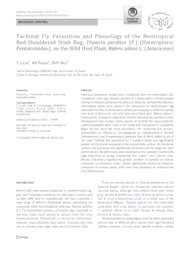Tachinid Fly Parasitism and Phenology of the Neotropical Red-Shouldered Stink Bug, Thyanta perditor (F.) (Heteroptera: Pentatomidae), on the Wild Host Plant, Bidens pilosa L. (Asteraceae).
Tachinid Fly Parasitism and Phenology of the Neotropical Red-Shouldered Stink Bug, Thyanta perditor (F.) (Heteroptera: Pentatomidae), on the Wild Host Plant, Bidens pilosa L. (Asteraceae).
Author(s): LUCINI, T.; PANIZZI, A. R.; DIOS, R. V. P.
Summary: Field and laboratory studies were conducted with the Neotropical redshouldered stink bug Thyanta perditor (F.) (Heteroptera: Pentatomidae) aiming to evaluate parasitismincidence on adults by tachinid flies (Diptera: Tachinidae), which were raised in the laboratory for identification. Egg deposition by flies on adult body surface was mapped. In addition, nymph and adult incidence on the wild host plant black jack, Bidens pilosa L. (Asteraceae), during the vegetative and the reproductive periods of plant development was studied. Seven species of tachinid flies were obtained: Euthera barbiellini Bezzi (73% of the total) and Trichopoda cf. pictipennis Bigot (16.7%) were the most abundant; the remaining five species, Gymnoclytia sp.; Phasia sp.; Strongygaster sp.; Cylindromyia cf. dorsalis (Wiedemann); and Ectophasiopsis ypiranga Dios & Nihei added 10.3% of the total. Tachinid flies parasitism on T. perditor adults was significantly greater on the dorsal compared to the ventral body surface. On the dorsal surface, the pronotum was significantly preferred and the wings the least preferred site. No differences were observed on the number of tachinid fly eggs deposited on wings, considering the ?under? and ?above? sites. Results indicated a significantly greater number of nymphs on mature compared to immature seeds. Adults significantly preferred immature compared to mature seeds; both were less abundant on leaves/stems and inflorescences.
Publication year: 2020
Types of publication: Journal article
Unit: Embrapa Wheat
Observation
Some of Embrapa's publications are published as ePub files. To read them, use or download one of the following free software options to your computer or mobile device. Android: Google Play Books; IOS: iBooks; Windows and Linux: Calibre.
Access other publications
Access the Agricultural Research Database (BDPA) to consult Embrapa's full library collection and records.
Visit Embrapa Bookstore to purchase books and other publications sold by Embrapa.

